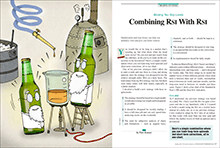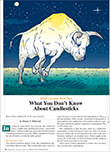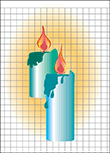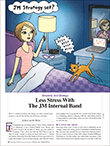Letters To The Editor
June 2011 Letters To The Editor
The editors of S&C invite readers to submit their opinions and information on subjects relating to technical analysis and this magazine. This column is our means of communication with our readers. Is there something you would like to know more (or less) about? Tell us about it. Without a source of new ideas and subjects coming from our readers, this magazine would not exist.
Address your correspondence to: Editor, Stocks & Commodities, 4757 California Ave. SW, Seattle, WA 98116-4499, or E-mail to editor@traders.com. All letters become the property of Technical Analysis, Inc. Letter-writers must include their full name and address for verification. Letters may be edited for length or clarity. The opinions expressed in this column do not necessarily represent those of the magazine. —Editor
COMBINING RSI WITH RSI
 Editor,
Editor,
I am a subscriber to your magazine and a student of technical analysis over the last 18 years. The subject is forever evolutionary and seldom do I come across an insight that can truly inspire and reflect upon the artistic nature that many professionals, working on charts, can possess. Peter Konner has done a wonderful job with the aspects mentioned in his January 2011 article (“Combining Rsi With Rsi”) and in its most simplest form. I just have one question for him: the rationale behind using the parameters for the weekly Rsi of 17 and 5.
Syed Rehan Ali
Author Peter Konner replies:
In my article, I briefly described the optimization performed on the model. I admit that it was a very sketchy test, but my subsequent optimizations show that five and 17 weeks for the Rsi periods are correct.
On a normal weekly chart I use a five-week Rsi combined with a simple moving average (MA) of 40 weeks (buy when Rsi rises above 60 and the price is greater than its simple moving average Sma(40), sell when Rsi falls below 40 and the price is below its Sma(40)). The five weeks was therefore given as a starting point, and I then had to find a slower Rsi by simple backtesting.
Same story goes with the moving averages of 10 and 40 weeks. Initially, these periods were chosen because of their simplicity, but my more thorough testing showed here as well an almost perfect correlation.
WHAT YOU DON’T KNOW ABOUT CANDLESTICKS
 Editor,
Editor,
First, I want to compliment you on your excellent magazine. I read it each month. Next, I would like to point out some issues I have with the March 2011 article by Thomas Bulkowski, “What You Don’t Know About Candlesticks.”
The author says he tested 103 candlestick patterns. As one of the original researchers of candlesticks in this country, I can say there are nowhere near 103 valid candlesticks patterns. The reason I say “valid” is because well-intentioned educators can make up their own candlestick patterns, but all the candlestick signals that I present in my educational materials have been refined and used by generations of traders in Japan.
I agree with the author’s reference to going with the primary trend. This brings out an important concept: Candlesticks are a tool and not a trading system. One of my Japanese resources said it well: “Adjustments to trading using a candlestick signal must be made, because to know where you stand is more important than pattern recognition.” In other words, you should not use candlestick patterns in isolation, whether for trading, investing, or testing.
For example, let’s say there’s a hammer that has a close of $20. The low of the hammer is $18, and your target is $19 (that is, a resistance area). If you buy on the hammer at $20, your risk (stop-out level) is $2, and the potential reward is only $1. This is a trade one should not take due to the poor risk/reward aspect. So, this hammer should not be used as a buy signal.
The author writes in his article, “I talked to a girl about candlesticks and told her that since a bearish harami occurred today, the price would likely close lower tomorrow.” This brings out a misunderstanding that many, including the author, understandably have about using candlesticks. They think that in the next session, the market will do what the candlestick signal implies. This is not the proper way to use candlesticks. One must be willing to risk the high or low of the candlestick signal when they make the trade, and not assume the next session will go in their favor.
For example, at our company, one approach to taking a trade that we teach is by using our Nison Candlestick Scanner software (reviewed in the November 2010 issue of S&C) to find hammers. Our trading strategy is we do not usually go long on the hammer (since we don’t make the assumption that the next session is going to rally). Instead, we wait for a correction to the lower part of the hammer’s shadow before buying. This gives us a trade with lower risk, since we are closer to the stop-out level of the hammer’s low. There are other considerations we also take into account before deciding to buy or not (for example, if one of the Western indicators we follow is also giving a buy signal). But the key point is, when there is a candlestick signal, it does not mean one should use it for a trade. Buying and selling on every candlestick signal is, as the Japanese proverb says, “Like leaning a ladder against the clouds.”
Steve Nison
Author Thomas Bulkowski replies:
An encyclopedia, by definition, is supposed to be comprehensive, so I included candlesticks found through numerous sources, both online and in print. They number 103, but I decided not to include additional candlesticks that resemble traditional chart patterns. I did not create any of the candlestick patterns that I cover in my book Encyclopedia Of Candlestick Charts.
I agree that some candlesticks are so rare that even finding them is difficult, but that shouldn’t preclude me from looking for them and testing those that I find. What about new developments in the field? Gregory Morris, for example, added a candle line to confirm a bearish engulfing pattern, which he calls a three outside down candlestick. Why not test it and include it in the book even if generations of Japanese traders haven’t traded it? To suggest that some candlesticks be excluded simply because they are new will tend to limit development in the field.
Years ago, when I first began learning about candlesticks, I thought that a reversal candlestick, such as a bearish harami, meant that the price trend would turn from up to down. Testing shows that’s not true. I use a close that is above the top of the candlestick pattern to signal an upward breakout and a close below the bottom of the pattern to signal a downward breakout. In a test of 20,000 bearish harami, I found that 8,122 break out upward, and 7,189 break out downward in a bull market. Thus, the candlestick pattern isn’t bearish, but bullish 53% of the time. That’s what I call near-random. In a bear market, the up/down breakouts number 2,342 to 2,347, respectively. The candlestick acts randomly. Those who build a trading system on the belief that a bearish harami is bearish could be in for a difficult time.
I wrote my Encyclopedia to give an unbiased, statistical appraisal of the performance of as many candlesticks as I could find. If the trader wishes to layer on Western indicators to improve performance, then good for him! How someone trades with candlesticks is entirely up to the individual.
Thanks for writing.
Editor: Steve Nison is president of Candlecharts.com and the author of Japanese Candlestick Charting Techniques. He has written several articles for Stocks & Commodities over the years. (See Traders.com to search for past articles.)
MORE ON CANDLESTICKS
 Editor,
Editor,
I read Thomas Bulkowski’s article on candlesticks in the March 2011 issue (“What You Don’t Know About Candlesticks”) and it was a real eye-opener. It confirmed some of my suspicions about candlesticks in the real world of real trades with real money.
A few years ago I watched a video about a piece of software for candlestick patterns that was new at the time. In it, the video author commented that just like a standalone indicator at random points, candles work 40% of the time. I have no definition of “work” other than I made money off the trade compared to the risk. I am currently considering buying Steve Nison’s candle scanner software for futures trading.
What I am finding, at least at this point with certain single-bar candles, is that trend has very little to do with the outcome of the trade. I looked at a daily chart of Potash Corp. (Pot) for my recent trade. (I think it’s called an “inverted hammer” here in Mississippi but “shooting star” by the academicians who so often write about trading but in fact never actually trade.) I am finding that my personal preference, at least for now, is for hammers, dojis, and engulfing bars. I also am finding that overlaying traditional Western technical analysis on candlesticks is basically useless for trading. I am not bright enough to understand multibar candle signals, and frankly, just as with traditional Western pattern recognition (which was formerly my expertise in the weekly and monthly degree), “beauty is in the eye of the beholder,” and I never met a “hindsight” pattern I did not love.
I truly look forward to Bulkowski’s next article and in the meantime I plan to order his book on candle patterns.
Randolph Bolen
Author Thomas Bulkowski replies:
That’s essentially what I found when testing candles. You might look at my free program, Patternz, that will find all the candles in my Encyclopedia and many chart patterns. It’s not Vista/Windows 7 compatible, but maybe you can get it to work on your setup. Perhaps it can be of use. Also, my website at https://thepatternsite.com will give you an idea of candle behavior as outlined in my book, too.
JM INTERNAL BAND
 Editor,
Editor,
I enjoyed Koos van der Merwe’s article in the December S&C, “JM Internal Band.” I like the simplicity of the concept. Unfortunately, backtesting using StockFetcher does not allow me to duplicate his results. I have tried backtesting using very favorable time periods such as 2009. I noticed that other readers have written to S&C to report not being able to duplicate his results either.
This makes me wonder whether there are criteria other than the ones given in the article. Please help me identify the problem, since I would really like to use the JM internal band system.
Bill Kloss
Author Koos van der Merwe replies:
I ran MetaStock Enhanced System Tester to determine performance. When I run the JM strategy as I write this using Portfolio Tester in OmniTrader, I get a return on investment (Roi) of 19.81%. Not bad, considering the market has been down for the past few weeks. I suggest that you play with the strategy. I must say it has been very kind to me over the years.
ERRATA: ARTWORK CREDIT
 The credit given for the artwork on page 38 of the May 2011 issue that accompanied the article “Context Is Everything” was incorrect. The artist who should have been credited was Ken Smith. We regret this error.
The credit given for the artwork on page 38 of the May 2011 issue that accompanied the article “Context Is Everything” was incorrect. The artist who should have been credited was Ken Smith. We regret this error.